Introduction
Mediterranean cuisine is celebrated around the world for its vibrant flavors, health benefits, and simplicity. This culinary tradition, rooted in countries bordering the Mediterranean Sea, emphasizes the use of fresh, high-quality ingredients that are both nourishing and satisfying. With its focus on plant-based meals, the Mediterranean diet encourages the consumption of whole foods, making it an appealing choice for those seeking to maintain a healthy lifestyle without sacrificing flavor.
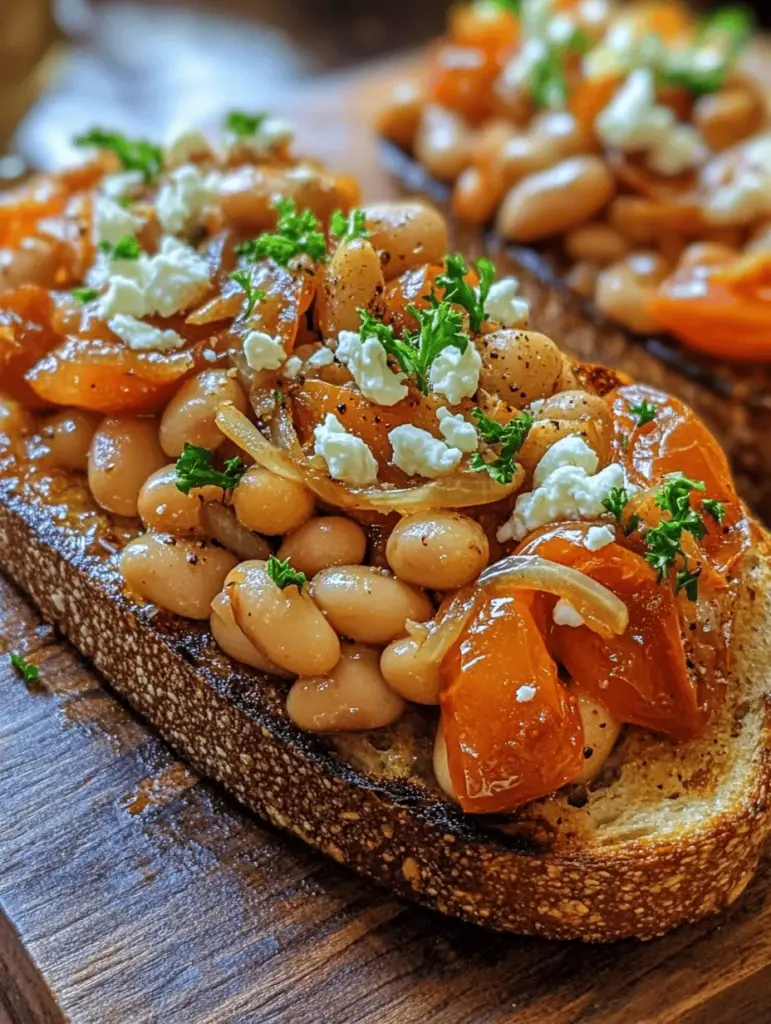
One standout dish that embodies the essence of Mediterranean cooking is Hearty Mediterranean Beans on Toast. This delightful meal can be enjoyed at any time of day, whether as a filling breakfast, a light lunch, or a comforting dinner. The combination of creamy beans, aromatic herbs, and robust spices, all served atop toasted bread, creates a satisfying dish that is as nutritious as it is delicious. Moreover, the recipe is incredibly easy to prepare, making it an ideal option for busy individuals or families looking for wholesome meals that don’t take hours in the kitchen.
The Mediterranean Diet: An Overview
The Mediterranean diet is more than just a way of eating; it is a lifestyle that promotes health and wellness through the consumption of whole, minimally processed foods. At its core, this dietary pattern emphasizes plant-based ingredients such as fruits, vegetables, whole grains, legumes, nuts, and seeds. Furthermore, it encourages the use of healthy fats, particularly from olive oil, and spices to enhance flavor without relying on excess salt.
1. Focus on Whole, Minimally Processed Foods: The Mediterranean diet champions the consumption of fresh, seasonal produce while minimizing processed and refined foods. This approach ensures that meals are not only flavorful but also packed with essential nutrients.
2. Emphasis on Plant-Based Ingredients: The diet places a strong emphasis on vegetables, legumes, and whole grains, which are rich in vitamins, minerals, and antioxidants. These ingredients provide the body with the necessary fuel for energy while promoting overall health.
3. Benefits of Healthy Fats, Particularly Olive Oil: Olive oil is a staple in Mediterranean cooking and is renowned for its numerous health benefits, including its ability to lower bad cholesterol and reduce the risk of heart disease. It is rich in monounsaturated fats and antioxidants, making it a heart-healthy option when compared to saturated fats.
4. Importance of Herbs and Spices for Flavor Without Excess Salt: The Mediterranean diet relies heavily on herbs and spices to infuse dishes with flavor, allowing for a reduction in salt without sacrificing taste. Ingredients such as garlic, basil, oregano, and rosemary are commonly used to enhance both flavor and nutritional value.
By adhering to these foundational principles, the Mediterranean diet not only supports physical health but also fosters a positive relationship with food, encouraging mindfulness and enjoyment during meals.
Ingredients Breakdown
Creating a delicious plate of Hearty Mediterranean Beans on Toast requires a selection of wholesome ingredients, each contributing unique flavors and nutritional benefits. Below, we explore the key components of this dish:
Cannellini Beans
Cannellini beans, often referred to as white kidney beans, are a staple in Mediterranean cooking. These legumes are not only creamy and delicious but also packed with nutritional benefits. They are an excellent source of protein and dietary fiber, making them a great choice for those seeking plant-based protein options. The high fiber content aids in digestion, helps maintain steady blood sugar levels, and promotes a feeling of fullness, making them an ideal ingredient for a hearty meal.
Fire-Roasted Diced Tomatoes
Fire-roasted diced tomatoes add a rich, smoky flavor to the dish, enhancing its overall taste profile. These tomatoes are typically canned and are a convenient option for home cooks. When selecting canned tomatoes, it is important to choose high-quality brands that use ripe, flavorful tomatoes without added preservatives or excessive sodium. Not only do these tomatoes provide a burst of flavor, but they also deliver essential vitamins such as vitamin C and antioxidants that support overall health.
Aromatics: Onion and Garlic
Aromatic ingredients such as onions and garlic form the foundation of many Mediterranean dishes, including this one. Onions contribute sweetness and depth, while garlic adds a pungent, savory flavor. Both ingredients are known for their health benefits, including anti-inflammatory properties and cardiovascular support. They are also rich in antioxidants, making them excellent additions to any meal.
Olive Oil
Olive oil is a key player in Mediterranean cuisine, celebrated for its rich flavor and health benefits. Extra virgin olive oil, in particular, is the highest quality and least processed form of olive oil, retaining the most nutrients. It is packed with monounsaturated fats, which are known to support heart health and reduce inflammation. Additionally, olive oil is rich in antioxidants, which can help protect the body from oxidative stress. When preparing Hearty Mediterranean Beans on Toast, drizzling the dish with quality olive oil can elevate its flavor and nutritional profile.
Herbs and Spices: Smoked Paprika, Oregano, and Red Pepper Flakes
The use of herbs and spices is essential to Mediterranean cooking, providing depth of flavor and numerous health benefits. In this recipe, smoked paprika, oregano, and red pepper flakes each play a significant role:
- Smoked Paprika: This spice lends a subtle smokiness and a vibrant red color to the dish. It contains antioxidants and may help boost metabolism.
- Oregano: A classic Mediterranean herb, oregano adds an earthy, aromatic flavor. It is rich in antioxidants and has been linked to anti-inflammatory properties.
- Red Pepper Flakes: These provide a touch of heat, balancing the creaminess of the beans. Capsaicin, the compound that gives red pepper its heat, is known to have pain-relieving properties and can aid in weight management.
Whole-Grain Bread or Sourdough
When it comes to serving Hearty Mediterranean Beans on Toast, the choice of bread is important. Whole-grain bread or sourdough is recommended for its nutritional benefits. Whole-grain bread retains the bran and germ from the grain, providing more fiber, vitamins, and minerals compared to white bread. Sourdough, on the other hand, is made through a fermentation process that can enhance digestibility and flavor. Both options offer a hearty base for the beans and contribute to a balanced meal.
Optional Toppings: Feta Cheese and Balsamic Glaze
To elevate the dish further, consider adding optional toppings such as feta cheese and balsamic glaze:
- Feta Cheese: This tangy cheese is a staple in Mediterranean cuisine and adds a creamy texture and salty flavor. Feta is lower in calories compared to many other cheeses and provides a source of calcium and protein.
- Balsamic Glaze: A drizzle of balsamic glaze can add a sweet and tangy contrast to the savory beans. Balsamic vinegar is rich in antioxidants and has been associated with various health benefits, including improved heart health and digestion.
Step-by-Step Cooking Instructions
Now that we have explored the ingredients that make Hearty Mediterranean Beans on Toast a nutritious and delicious option, let’s delve into the step-by-step cooking instructions to create this satisfying dish.
1. Prep the Ingredients: Start by gathering all your ingredients. Rinse the cannellini beans under cold water and set them aside. If using fresh aromatics, finely chop the onion and garlic.
2. Sauté the Aromatics: In a medium-sized skillet, heat a generous drizzle of extra virgin olive oil over medium heat. Add the chopped onion and sauté until it becomes translucent, about 5 minutes. Then, add the minced garlic and cook for an additional minute until fragrant.
3. Add the Tomatoes and Spices: Pour in the fire-roasted diced tomatoes, along with their juices, and stir to combine. Add the smoked paprika, oregano, and red pepper flakes. Allow the mixture to simmer for about 5-7 minutes, letting the flavors meld together.
4. Incorporate the Beans: Gently fold the rinsed cannellini beans into the tomato mixture. Stir well to ensure the beans are evenly coated with the sauce. Continue to cook for an additional 5 minutes, allowing the beans to heat through.
5. Toast the Bread: While the beans are simmering, toast your choice of whole-grain bread or sourdough until golden brown. This will provide a crispy base for the hearty bean mixture.
6. Assemble the Dish: Once the beans are warmed through and the toast is ready, spoon the hearty bean mixture generously over the toasted bread. Drizzle with extra virgin olive oil and top with crumbled feta cheese and a drizzle of balsamic glaze, if desired.
With these simple steps, you can create a flavorful and nutritious dish that embodies the essence of Mediterranean cuisine. Enjoy your Hearty Mediterranean Beans on Toast as a filling meal that nourishes both body and soul!
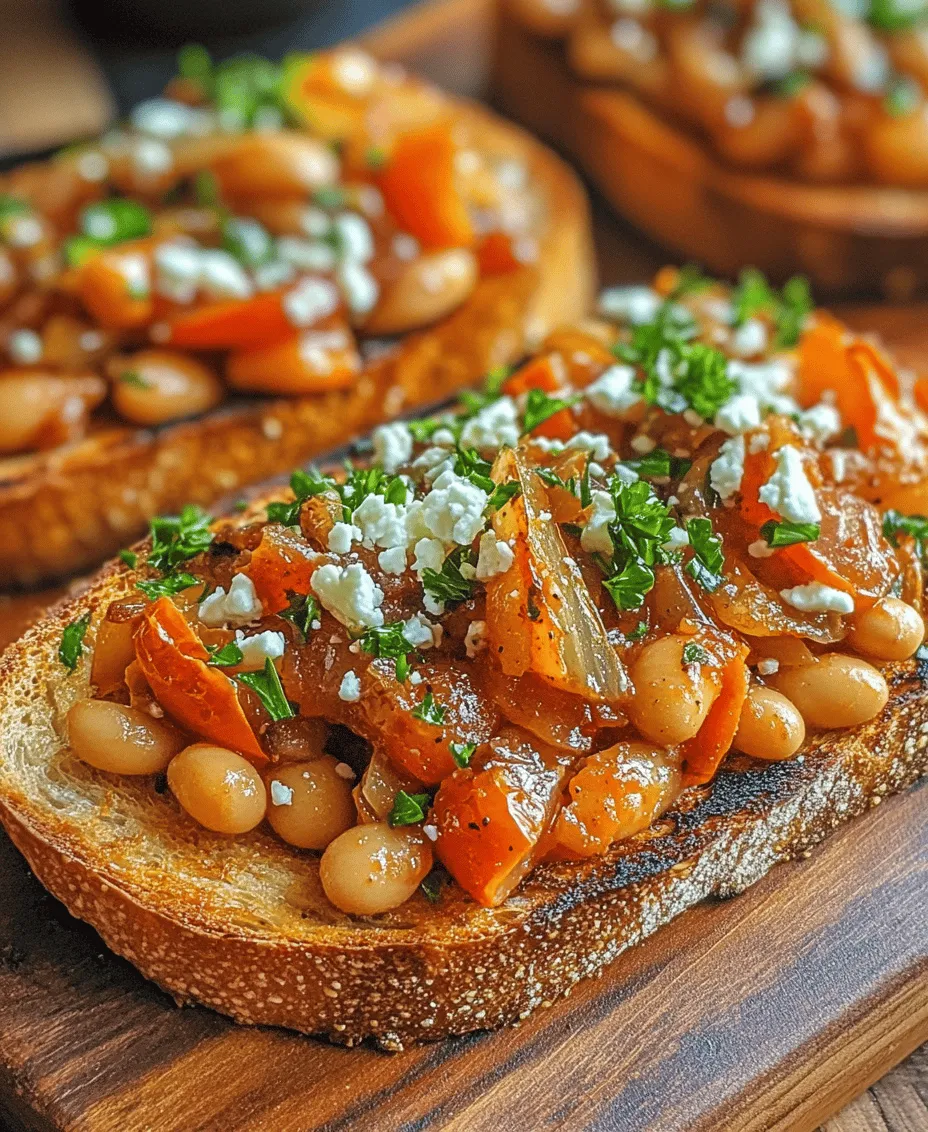
Sautéing the Aromatics
Sautéing is a fundamental step in many recipes, and in our Hearty Mediterranean Beans on Toast, it plays a crucial role in building flavor. Onions and garlic, the aromatic base of this dish, should be cooked properly to unlock their full potential. Start by heating a generous drizzle of olive oil in a medium skillet over medium heat.
When the oil is shimmering but not smoking, add finely chopped onions. The goal is to soften them and allow their natural sweetness to emerge. Stir them frequently and allow them to cook for about 5-7 minutes until they become translucent. Next, add minced garlic—ideally, about 3-4 cloves for that robust Mediterranean flavor. It’s important to add garlic after the onions have started to soften; this prevents it from burning and becoming bitter. Sauté for an additional 1-2 minutes, just until the garlic is fragrant, making sure it does not brown.
Tips for Achieving the Perfect Sauté:
- Use a non-stick or cast-iron skillet to prevent sticking.
- Maintain medium heat; too high can burn the ingredients, while too low will lead to uneven cooking.
- Stir frequently to ensure even cooking and prevent burning.
Cooking the Beans
Next, we turn our attention to the beans, the star of this dish! Whether you’re using canned beans or cooking dried beans from scratch, the method is similar. If using canned beans, be sure to rinse and drain them to remove excess sodium. For dried beans, soak them overnight and boil until tender, which can take up to an hour depending on the variety.
Once your beans are prepped, add them to the skillet with the sautéed aromatics. Stir to combine, then pour in a splash of vegetable broth or water—enough to create a slight simmer. The simmering process is essential, as it allows the beans to absorb the flavors of the onions, garlic, and any additional herbs and spices you may choose to include, such as oregano or cumin. Season with salt and pepper to taste.
Importance of Simmering for Texture and Depth:
- Simmering allows the beans to become tender while soaking up the aromatic flavors.
- A low simmer keeps the beans intact and prevents them from becoming mushy. Aim for about 10-15 minutes of simmering, stirring occasionally.
Preparing the Toast
While the beans are simmering, it’s time to prepare the toast. The type of bread you choose can significantly affect the dish’s overall flavor and texture. A hearty sourdough or whole-grain bread works well, providing a satisfying crunch and flavor.
You can toast your bread using either a toaster or a broiler. If using a toaster, aim for a medium setting to achieve a nice golden-brown color. If opting for the broiler, place the bread on an oven-safe baking sheet and toast it under the broiler for about 1-3 minutes per side, keeping a close eye to prevent burning.
Tips for Achieving the Perfect Crispness:
- Lightly brush the bread with olive oil before toasting for added flavor and extra crispness.
- Allow the toasted bread to sit for a minute or two after toasting; this helps maintain its crunch when topped with the warm bean mixture.
Assembling the Dish
Now that everything is prepped, it’s time to bring your Hearty Mediterranean Beans on Toast together! Start by placing the toasted bread on a plate. Spoon a generous portion of the warm bean mixture over each slice, ensuring that there are plenty of beans and the aromatic broth drizzled on top.
Techniques for Plating and Presentation:
- Use a slotted spoon for serving to avoid making the bread soggy.
- Consider adding a drizzle of high-quality olive oil or a sprinkle of chili flakes for an extra kick.
- Garnish with fresh herbs such as parsley or basil for a pop of color and freshness.
Balancing flavors and textures is crucial. The crunchy toast contrasts beautifully with the soft, savory beans, creating a delightful eating experience.
Garnishing and Serving
Garnishing not only enhances the visual appeal of your dish but also complements its flavors. Fresh herbs are a fantastic way to add brightness and freshness. Try finely chopping parsley, cilantro, or chives and sprinkling them over the top. A squeeze of fresh lemon juice can also elevate the dish, adding a zesty finish that brightens the overall flavor profile.
For serving suggestions, consider pairing your Hearty Mediterranean Beans on Toast with a simple side salad of arugula and cherry tomatoes, dressed lightly with olive oil and balsamic vinegar. This adds a refreshing contrast to the rich beans and enhances the Mediterranean theme.
Nutritional Information
Understanding the nutritional content of your dish can help you appreciate its health benefits. Here’s a breakdown of the nutritional information per serving of Hearty Mediterranean Beans on Toast:
- Calories: Approximately 350-400 calories
- Macronutrients:
- Protein: 15g
- Fats: 10g
- Carbohydrates: 60g
- Micronutrients:
- Fiber: 12g (great for digestive health)
- Iron: 15% of daily value (supports energy levels)
- Vitamin C: 20% of daily value (boosts immune function)
This dish is not only filling but also a great source of plant-based protein, making it an ideal choice for vegetarians and vegans alike.
Variations and Customizations
One of the best things about Hearty Mediterranean Beans on Toast is its versatility. You can easily modify the recipe to cater to different dietary preferences or personal tastes.
Vegan Version
This recipe is inherently vegan, but you can enhance it with plant-based toppings. Consider adding sliced avocado or a dollop of dairy-free yogurt for creaminess. Nutritional yeast can also be sprinkled on top for a cheesy flavor without the dairy.
Gluten-Free Option
For those following a gluten-free diet, selecting the right bread is essential. Many brands offer gluten-free bread made from rice flour, almond flour, or other gluten-free grains. Ensure that any toppings or additional ingredients are also gluten-free to maintain the integrity of the meal.
Protein Additions
If you’re looking to increase the protein content of your dish, there are several options. A poached or fried egg on top can add richness and additional protein. Alternatively, you could incorporate chickpeas or lentils into the bean mixture for a protein boost while keeping the Mediterranean theme intact.
Cultural Significance of Beans in the Mediterranean Diet
Beans hold a prominent place in Mediterranean cuisine, celebrated for their nutritional value and versatility. Historically, beans have been a staple food in this region, providing sustenance and protein to populations for centuries. They are deeply woven into the culinary fabric of cultures in countries like Italy, Greece, and Spain, often featured in salads, stews, and spreads.
Regional variations abound, with each culture bringing unique spices and cooking methods to the table. In Italy, for example, cannellini beans are common, while in Spain, chickpeas are often used in traditional dishes like pisto. The use of beans reflects the Mediterranean diet’s emphasis on whole foods, local produce, and healthy fats, contributing to its reputation as one of the healthiest eating patterns globally.
Conclusion
Hearty Mediterranean Beans on Toast is a versatile, nutritious, and satisfying meal that embodies the rich flavors of Mediterranean cuisine. With its easy preparation and customizable nature, it encourages you to incorporate more plant-based options into your diet, all while enjoying the delightful combination of textures and flavors.
By experimenting with this recipe and exploring the various modifications, you can appreciate the cohesive balance of health and taste that Mediterranean-inspired dishes offer. Whether enjoyed as a hearty breakfast, a light lunch, or a satisfying dinner, this dish is sure to become a staple in your kitchen. Embrace the flavors of the Mediterranean and elevate your meals with this delicious recipe!
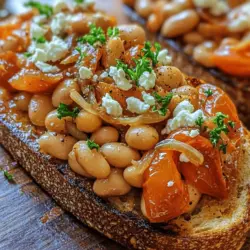

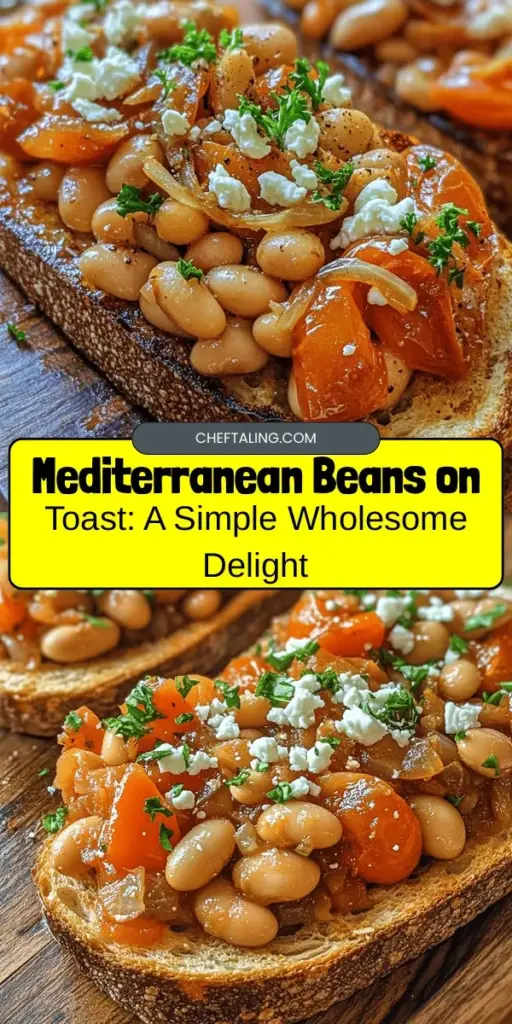

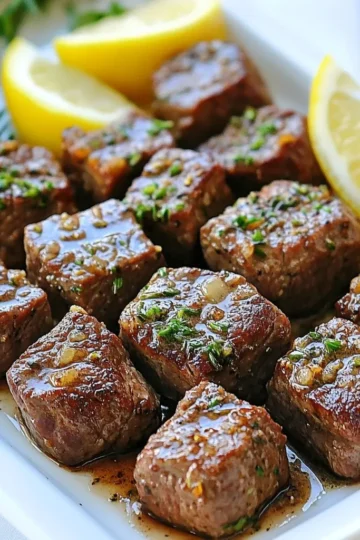
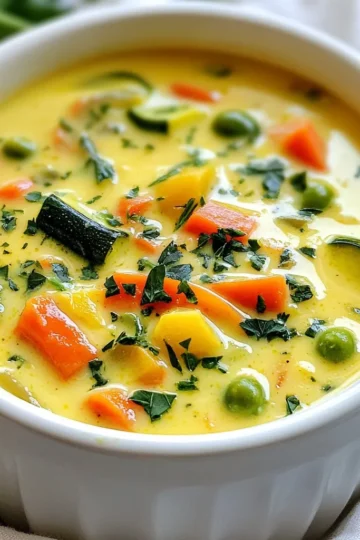
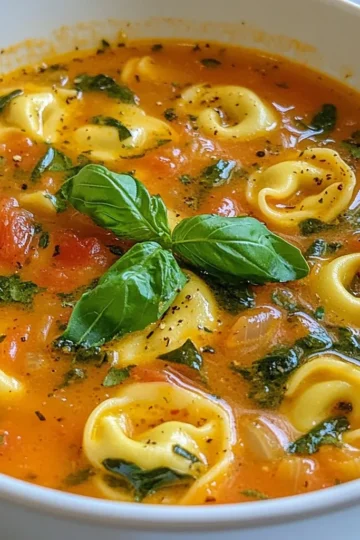
Leave a Reply